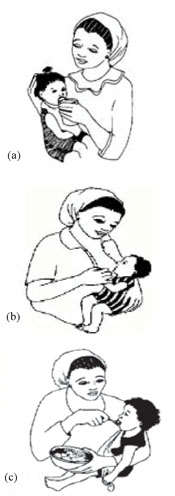Treatment
The treatment of any faeco-oral disease depends on whether the patient has diarrhoea or not. Patients without diarrhoea are treated depending on the type of infectious agent responsible.
For patients with diarrhoea, especially children, the core measure in the treatment is rapid and adequate rehydration – fluid replacement – usually by drinking fluids. In the most severe cases the fluid has to be given intravenously (directly into a vein). Rehydration is the most important component of treatment for diarrhoea and it should be started as soon as possible and continued for as long as necessary. The best fluid to use to avoid the dangers of dehydration is a solution of oral rehydration salts (ORS) – a packet containing sugar and salts in the correct amounts, which the caregiver dissolves in clean drinking water. The sugar and salts are absorbed into the child's body, replacing what it has lost in the diarrhoea; the salts also help water to be absorbed across the inflamed lining of the gut, where it has been damaged by the action of infectious agents. WHO Guidelines on the Treatment of Diarrhoea now also emphasise the importance of giving zinc supplements to young children with diarrhoea, in addition to ORS.
For children with diarrhoea, the measures that you need to undertake during treatment are briefly summarised in the box below. However, the WHO estimates that less than 40% of children with a diarrhoeal disease receive the correct treatment.
Summary of the main measures to treat a child with diarrhoea
In order to treat a child with diarrhoea effectively, you have to learn the detailed descriptions of each of these measures:
- First, you have to assess the degree of dehydration and classify the child as having 'no', 'some' or 'severe' dehydration, depending on specific symptoms and signs.
- Select and apply the appropriate treatment for the degree of dehydration.
- Check for other general danger signs indicating other major health problems, such as malaria, malnutrition or pneumonia, and treat them; e.g. if the child has malaria, give appropriate antimalarial drugs.
- Counsel the mother on how to give ORS at home (figure a, below); if she does not have ORS, the child should be encouraged to drink as much clean fluids as possible.
- If the child is breastfed, the mother should go on breastfeeding during diarrhoea episodes (figure b, below); weaned children need additional nourishing meals to help them recover their strength (figure c, below)

For adults with diarrhoea, assess whether the patient can take fluids orally, and if they cannot, refer them immediately to the nearest higher level health facility. If the patient is able to take fluids orally, give ORS and tell them to drink 200–400 ml after each loose stool. You should also advise the patient to take other fluids in addition to ORS and to continue eating. For most cases of diarrhoea in adults, additional treatment (other than rehydration) is generally required – mainly giving an antibiotic or other medication appropriate for the specific infectious agent. However, laboratory examination of stool samples is required before making the diagnosis. Therefore, give ORS to adults with diarrhoea and refer them. Advise the patient that early treatment is important because the disease could worsen rapidly.